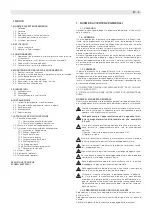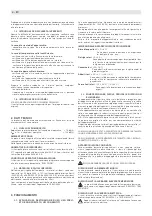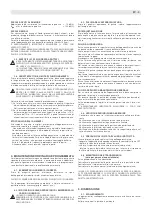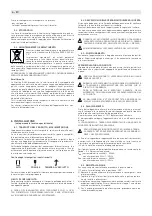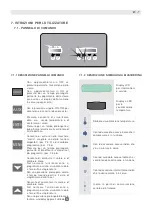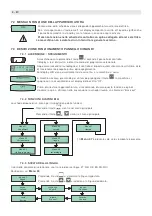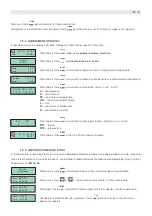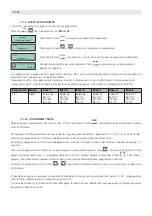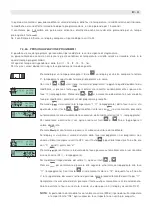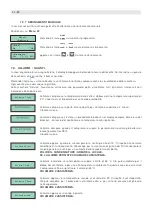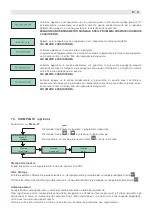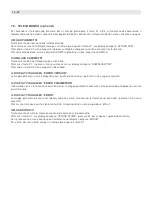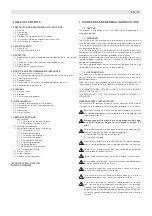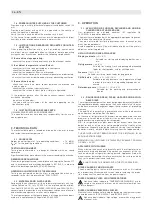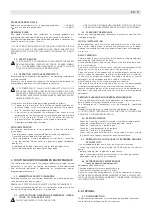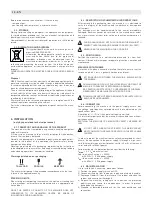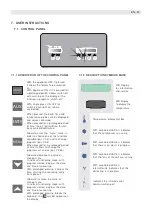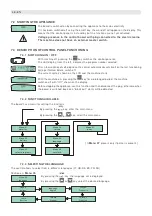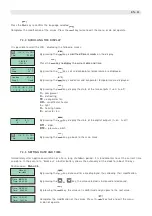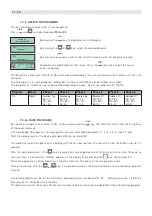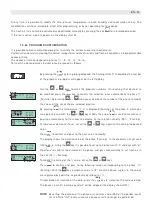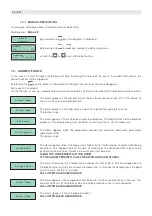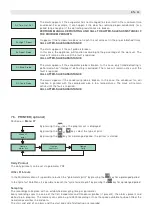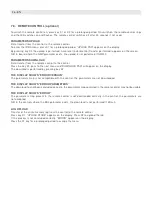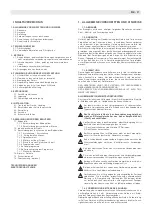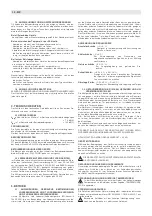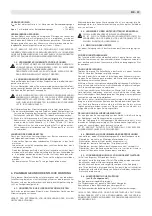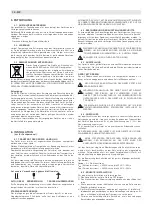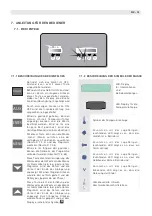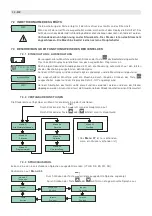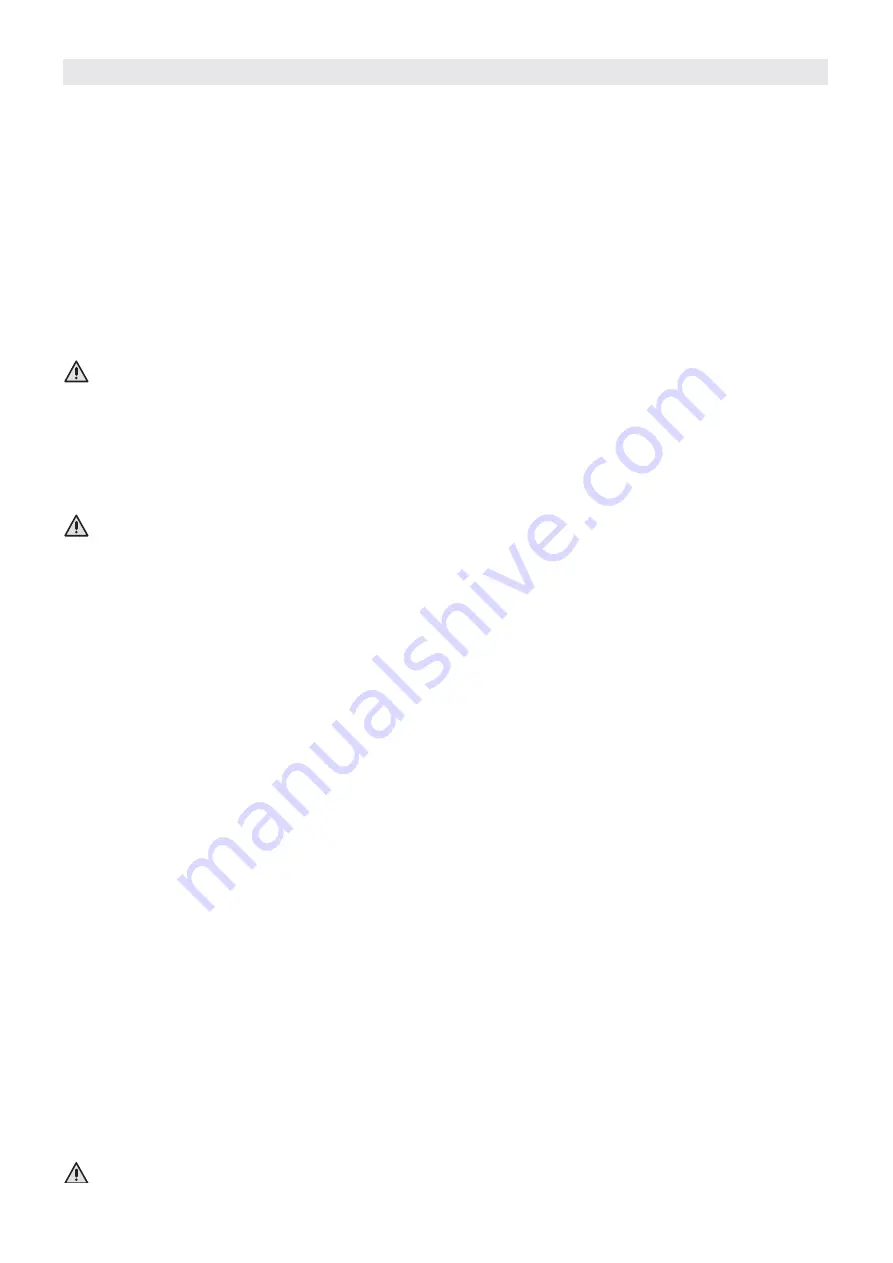
EN - 17
RI SKS CAUSED BY NOI SE
Leq
at the noisiest point at 1m in operating conditions < 70 dB(A)
Lpc
at 1m in operating conditions
< 130 dB(C)
RESI DUAL RI SKS
Any liquids emanating from foodstuffs or washing products are
prevented from leaking outside by a drain positioned at the bottom.
During cleaning operations, remove the plug and place a collection tray
under the machine (Hmax= 100mm).
I T I S OF UTMOST I MPORTANCE THAT THE PLUG I S REFI TTED I N THE
HOLE. I N THE CASE OF MACHI NES WI TH NO DRAI N, PREVENT THE
STAGNATI ON OF LI QUI DS BY CLEANI NG THOROUGHLY ON A DAI LY
BASI S.
3.3. SAFETY DEVI CES
I T I S PROHI BI TED TO TAMPER WI TH OR REMOVE THE SAFETY
DEVI CES PROVI DED (PROTECTI ON GRI LLS, DANGER LABELS,
ETC.). THE MANUFACTURER DECLI NES ALL LI ABI LI TY SHOULD
THE SAI D I NSTRUCTI ONS NOT BE RESPECTED.
3.4. OPERATI ON LI MI T CHARACTERI STI CS
Before loading the produce in the appliance, the operating temperature
must be reached.
Make sure the thermometer indicates the temperature previously set
and gradually load over time the produce to conserve.
I T I S FORBI DDEN TO PLACE LI QUI DS AND HOT FOOD I N THE
APPLI ANCE. MAKE SURE ONLY PRODUCE COVERED WI TH AP-
PROPRI ATE PAPER OR PROTECTI VE FI LM I S PLACED I N THE
APPLI ANCE; SAVE FOR APPLI ANCE WHERE FORESEEN (FOR EX-
AMPLE: BLASTERS CHI LL).
I n the event of a failure of power supply, proceed as follows:
1) I f power failure is minimal, there will be no speci
fi c problems be-
cause the fridge is well insulated and will maintain the tempera-
ture. I n the mean time, avoid opening the door;
2) I f the current cut-off exceeds the maximum time, check that the
temperature on the thermometer is not above operation threshold
of + 10°C in the case of TN and -15°C in the case of BT, then en-
sure overtime that the produce in the fridge is not altered.
I f possible, avoid opening the door.
STORI NG PRODUCE
For optimum performance of the appliance, follow the indications
given below:
- Do not place hot food or uncovered liquids inside the appliance;
- Cover and protect food with strong odours;
- Store the produce inside the appliance so that the air circulation
is not obstructed. Do not cover the grids with paper, cardboard,
boards etc;
- Avoid opening the door frequently and for long period of times;
- Wait a few seconds before opening the door again.
4. ROUTI NE AND PROGRAMMED MAI NTENANCE
The information contained in this chapter addresses suitable, trained
personnel in the case of routine maintenance; while specialised
and authorised personnel is addressed for extraordinary and/ or
programmed maintenance.
4.1. ELEMENTARY SAFETY STANDARDS
Before performing any intervention, disconnect the machine plug from
the electrical mains power supply.
REMOVAL OF PROTECTI ONS OR SAFETY DEVI CES I S PROHI BI TED.
I n routine maintenace operations, the removal of protections/ saftey
devices (grills, adhesive labels, etc.) is prohibited.
4.2. I NSTRUCTI ONS REGARDI NG EMERGENCY OPERA-
TI ONS I N THE CASE OF FI RE
DO NOT USE WATER I N THE CASE OF FI RE.
USE CO
2
FI RE EXTI NGUI SHER (CARBON DI OXI DE) AND COOL
THE MOTOR COMPARTMENT AREA AS QUI CKLY AS POSSI BLE.
4.3. CLEANI NG THE MACHI NE
Before any cleaning operation, disconnect the machine from the elec-
trical power supply.
I NI TI AL I NSTALLATI ON
Before operating, wash the interior and accessories with a little water
and neutral soap in order to remove the characteristic “new” odour.
Arrange the accessories inside the cabinet in positions most appropri-
ate for use.
DAI LY CLEANI NG
Carefully clean the external surfaces of the machine using a damp cloth
and following the direction of the
fi nish.
Use neutral detergents and not substances with a chlorine base and/
or that are abrasive.
Do not use utensils which may cause scratches and consequently the
formation of rust. Rinse with clean water and dry carefully.
Clean the interior of the cabinet with neutral detergents which do not
contain chlorine or abrasives, to avoid the formation of dirt residues.
I n the case of hardened residues, use soap and water or neutral
detergents, using a wooden or plastic spatula if necessary.
After cleaning, rinse with a little water and dry carefully.
Do not wash the machine with direct water jets, as any water leakage
into electrical components may affect their correct functioning.
Lower and adjoining areas of the machine must also be cleaned on a
daily basis with soap and water and not with toxic or chlorine-based
detergents.
PERI ODI C CLEANI NG AND GENERAL MAI NTENANCE
Cleaning and general maintenance operations must be carried out to
ensure the consistent performance of the machine.
The refrigerator unit (condenser) must be cleaned by specialised
personnel.
Regularly clean the drain to avoid that the hole becomes blocked.
I T I S OF UTMOST I MPORTANCE THAT THE HOLE I S CLOSED ONCE
AGAI N WI TH THE APPROPRI ATE PLUG.
4.4. PERI ODI C CHECKS
- Check that the plug is correctly inserted in the power supply socket.
- Check that the appliances are not affected by heat sources.
- Check that the machine is perfectly level.
- Check that the door gasket seals perfectly.
- Check that the drain is not blocked.
- Check that the condenser battery is not covered with dust; should
this be the case, request after-sales technical assistance.
4.5. PRECAUTI ONS I N THE CASE OF EXTENDED PERI ODS
OF I NACTI VI TY
I f an extended period of inactivity of the machine is foreseen:
- switch the machine off by pressing the OFF button on the control
panel;
- remove the plug from the power supply socket;
- empty the refrigerator and carefully clean it (see cleaning section);
- leave doors ajar to ensure air circulation.
4.6. EXTRAORDI NARY MAI NTENANCE
( only by specialised personnel)
Periodically clean condenser.
Check door gaskets to ensure perfect sealing.
Check that the electrical system is in order.
Check the surround heating elements (using an amperometric clamp).
I N THE CASE OF REPAI RS OR REPLACEMENT OF PARTS, ALWAYS PRO-
VI DE THE CODE AND SERI AL NUMBER OF THE MACHI NE, VI SI BLE ON
THE SPECI FI CATI ONS PLATE.
5. DI SPOSAL
5.1. DI SCONNECTI ON
The disconnection operations must be done by quali
fi ed technicians.
Avoid spilling or leakage into the environment

